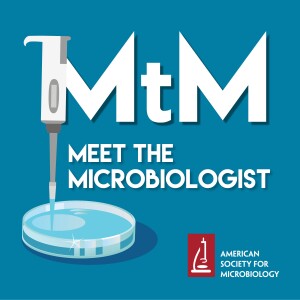
079: Comparative Bacterial Genomics with Dave Rasko
 2018-03-29
2018-03-29
Dave Rasko uses comparative bacterial genomics to find DNA sequences that influence virulence or antibiotic resistance. Dave talks about his studies of E. coli, Acinetobacter baumanii, and B. anthracis, and the state of bacterial genomics past, present, and future.
Host: Julie Wolf
Subscribe (free) on iPhone, Android, RSS, or by email. You can also listen on your mobile device with the ASM Podcast app.
Julie's biggest takeaways:
Genome sequencing speed has significantly increased: The first bacterial genome sequenced, Haemophilus influenzae, took about 10 years to complete. The first organism with two sequenced genomes was Helicobacter pylori, published in 1999, and the first organism with three published genomes was Escherichia coli. Rasko’s initial project at TIGR to sequence 11 E. coli genomes took about 2 years. Today, Rasko’s lab can sequence 500 genomes in about five days.
In E. coli, up to half of the genome can differ between two strains. The core genome is the collection of genes that will be shared among all isolates of a particular species. Core gene conservation varies among species and is important to consider in analyses for one’s species of interest.
Working on the Amerithrax investigation was unlike many other scientific inquiries for many reasons, including that the Federal Bureau of Investigation only gave the scientists involved the information pieces necessary to conduct their studies. Rasko and collaborators sequenced the genomes of spores within the samples, and found that the morphology of the colonies that grew were associated with genetic differences between the spores within the sample, linking phenotype and genotype.
While comparative genomics can provide a lot of information, there are some phenomena that will always require further study. For example, Rasko is researching isolates of A. baumanii and Klebiella pneumoniae that quickly develop drug resistance when grown in sub-inhibitory drug concentrations. The genomic sequences of resistant or susceptible strains show no difference in DNA sequence, suggesting the phenotype is due to transcriptional changes.
“Genomics is fun in that we can hypothesize all day long, every day. It’s really the start of a lot of very very hard work figuring out why.”
“There’s a lot of DNA pieces that we don’t fully understand how they moved, where they moved, where they came from. In some cases, there’s evidence to say where they came from; in terms of G-C content and coding biases, we can make some assumptions, but in the grand scheme of things, we have no idea where they’re coming from! In some cases, we’ll see them dominant throughout a lineage, and in some cases we’ll see them in sporadic isolates around the entire phylogenetic tree. . .We all thought genomics was going to solve so many problems, and it’s really just made it more difficult!”
“Plasmids tend to be mobile and exchangeable, and the pieces tend to be - I tend to think of them as legos, in the fact that you can put a plasmid together in a bunch of different ways.”
“I think a lot of conventional PCR fails and people assume that it’s because it’s negative, and not necessarily that it fails because of diversity.”
“Many microbiologists think of that colony on a plate as a clone. I force the people in my group to think about it a little differently, because it’s really what I like to call ‘genome space’. They’re not all the same; bacteria are constantly evolving. There’s changes all the time, some of them are positive, some of the are negative, the negative ones get lost, the positive ones unusually become dominant - and then there’s lots of neutral changes that just kind of hang out.”
“Genomes really normalized everything. Before that, there were certain labs that could clone and there were certain labs that could sequence, and it was a little bit restrictive to the elite labs who had those resources. Now with the genome sequences out there, everyone was starting from the same place.”
“You really have to understand your organism to make the bioinformatics work.”
Links for this episode
Rasko lab at the University of Maryland FBI summary of Amerithrax investigation 2011 PNAS report on B. anthracis comparative genomics Bugs N the ‘hoodSend your stories about our guests and/or your comments to jwolf@asmusa.org.
More Episodes
 2010-01-06
2010-01-06
 2009-10-23
2009-10-23
 2009-10-09
2009-10-09
 2009-05-07
2009-05-07
 2009-04-17
2009-04-17
Create your
podcast in
minutes
- Full-featured podcast site
- Unlimited storage and bandwidth
- Comprehensive podcast stats
- Distribute to Apple Podcasts, Spotify, and more
- Make money with your podcast
It is Free
- Privacy Policy
- Cookie Policy
- Terms of Use
- Consent Preferences
- Copyright © 2015-2024 Podbean.com




